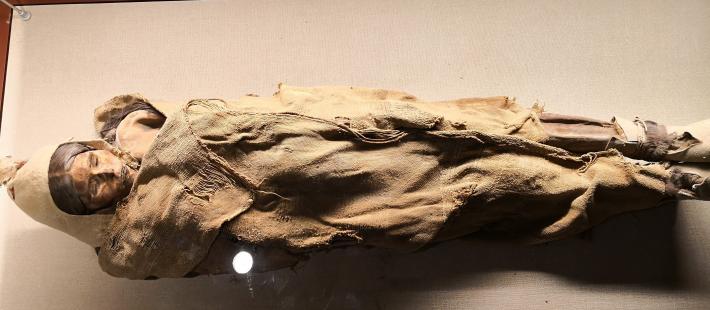The story of the Beauty of Loulan is as fascinating as it is mysterious. Discovered in 1980 in the desolate Tarim Basin of China’s Xinjiang region, this ancient mummy dates back 4,000 years to the Bronze Age. Known for her remarkably well-preserved features, she is one of many Tarim mummies whose bodies were naturally mummified by the desert’s arid conditions. What makes Loulan’s discovery exceptional is the range of cultural and scientific insights she offers about migration, survival, and the cultural exchanges of early Eurasian societies.
1. A Bronze Age Mystery and the Power of Natural Mummification
Loulan was found near the ancient Silk Road, a route that would later become a vital artery connecting East and West. But in her time, around 2000 BCE, Loulan’s homeland was a remote part of the world. Her preservation was unintentional; the region’s dry climate, combined with high salt content from nearby salt lakes, naturally desiccated her body. This unplanned preservation kept her facial features almost intact, including delicate details like her eyelashes and traces of hair, allowing researchers a rare and authentic look at her appearance. Unlike Egyptian mummies, whose preservation was achieved through skilled embalming, Loulan’s body survived without any human intervention—a testament to the powerful environmental forces of the Tarim Basin.
 .
.
2. Science Meets History: Genetic Clues to Her Ancestry
DNA testing has revealed surprising results about Loulan’s ancestry. Her genetic markers are associated with significant European traits, indicating that her people might have come from regions in Siberia or even Western Eurasia before eventually settling in Xinjiang. This genetic evidence suggests a complex web of migration routes and population mingling far earlier than previously understood, highlighting that ancient societies in Asia were more diverse than expected. Her story reflects a period when the Eurasian landmass was a tapestry of cultures and peoples who moved across vast distances, blending with indigenous groups as they adapted to new environments.
3. Living Conditions and Adaptations of the Tarim Basin’s Inhabitants
Loulan’s people faced extreme environmental challenges in the Tarim Basin. Situated in one of the harshest deserts on Earth, their survival depended on their ability to adapt to extreme drought and scarce resources. These communities likely relied on deep wells, cultivated drought-resistant plants, and took advantage of trade routes to procure goods. The dry climate not only preserved Loulan’s remains but also left behind textiles, tools, and artifacts that offer a glimpse into the resourcefulness and resilience of her community.
4. Cultural and Symbolic Insights from the Silk Road’s Beginnings
Although the Silk Road would only officially come into existence centuries after Loulan’s death, the early migrations of her people foreshadowed the movement of goods and ideas that would later flourish along this route. Her existence on this distant frontier points to cultural exchanges that may have been underway long before silk, spices, and other luxuries became common trade items. The very fact that European genetic markers are present in Loulan suggests that the concept of a singular “Silk Road” is, in fact, a continuation of much older patterns of exploration, communication, and integration.
5. Preservation and Legacy: What the Beauty of Loulan Teaches Us
Loulan’s well-preserved remains challenge our understanding of Bronze Age Eurasia, revealing a cultural landscape of surprising complexity. Her journey from anonymity in the desert to a respected place in museum collections invites a fresh look at the lives of ancient peoples who thrived at the edges of known civilizations. Her natural preservation connects us directly with the past, offering a haunting reminder that history is not confined to grand empires or famous figures but is written in the lives of ordinary individuals who left subtle, invaluable traces.
Conclusion: The Beauty of Loulan as a Symbol of Ancient Connections
The Beauty of Loulan stands as a silent symbol of endurance, migration, and cultural interconnections that predate modern conceptions of history. Her story is a humbling reminder of the complexity and depth of human history, urging us to look beyond borders and recognize the interconnected heritage we share. Through Loulan, we glimpse the spirit of ancient humanity—one that adapted, traveled, and bridged worlds long before the Silk Road, and whose story resonates across millennia as we continue to uncover the layers of our shared past.

